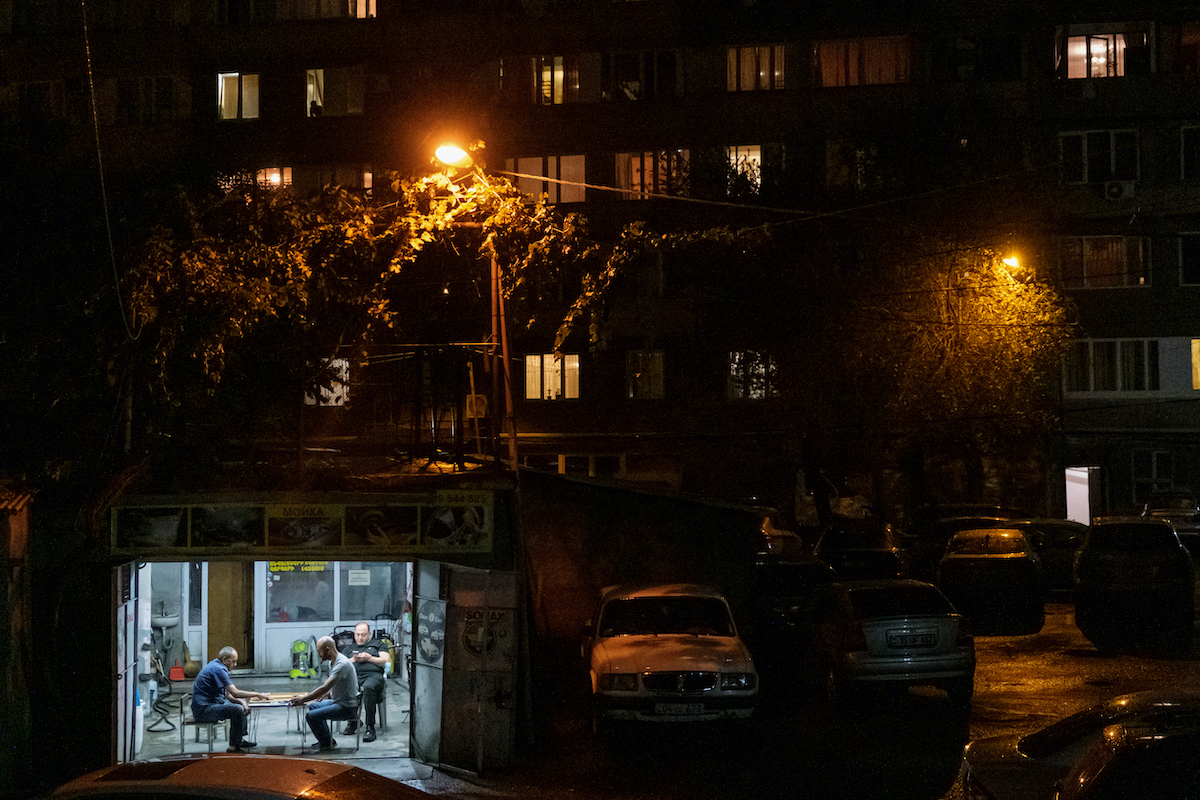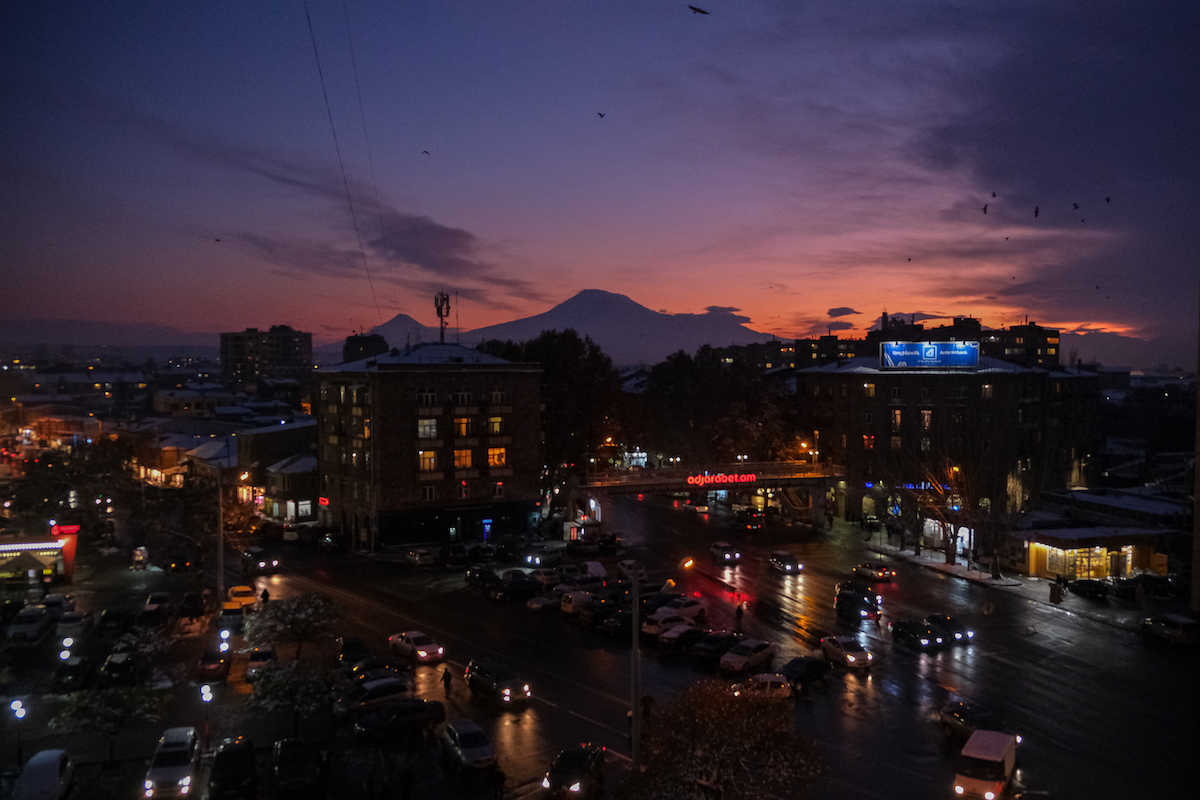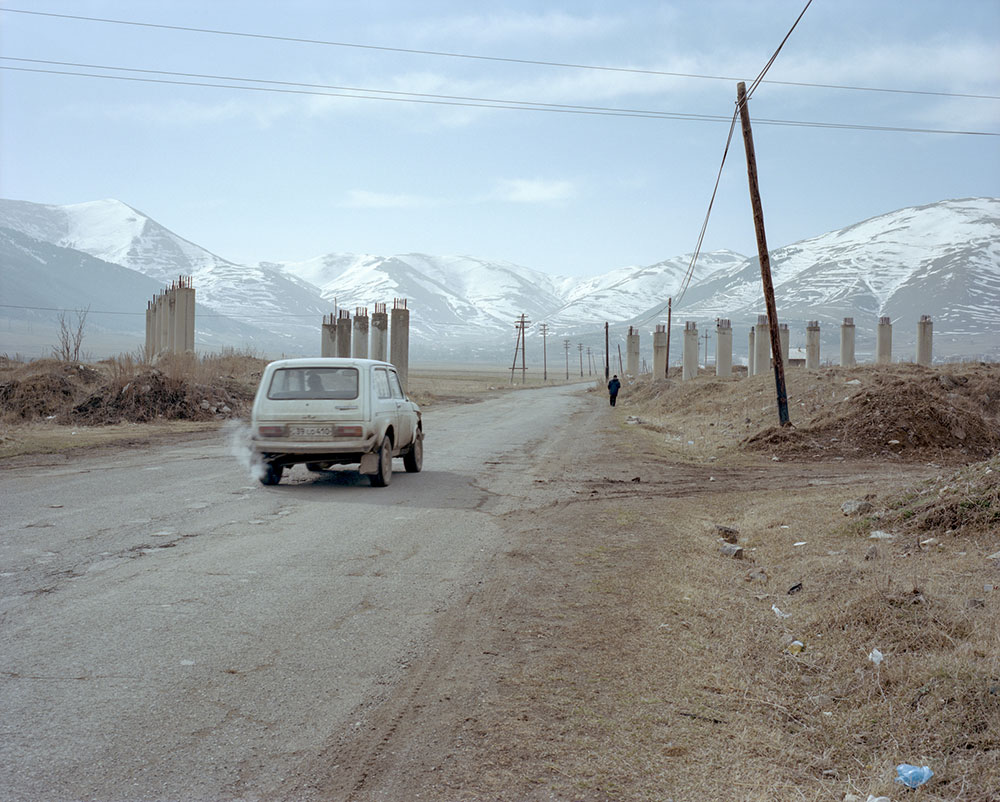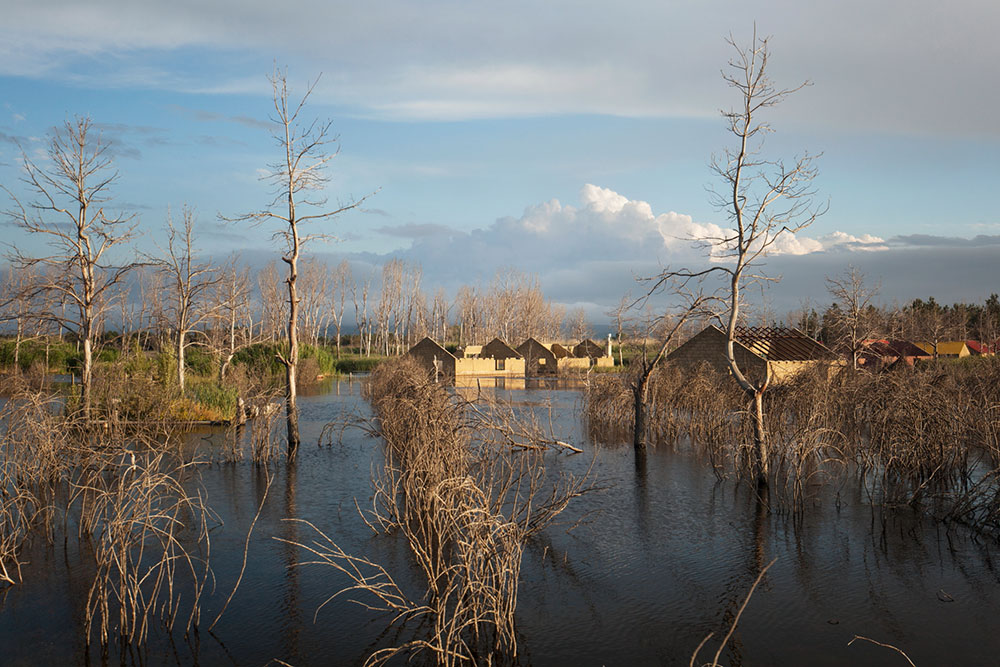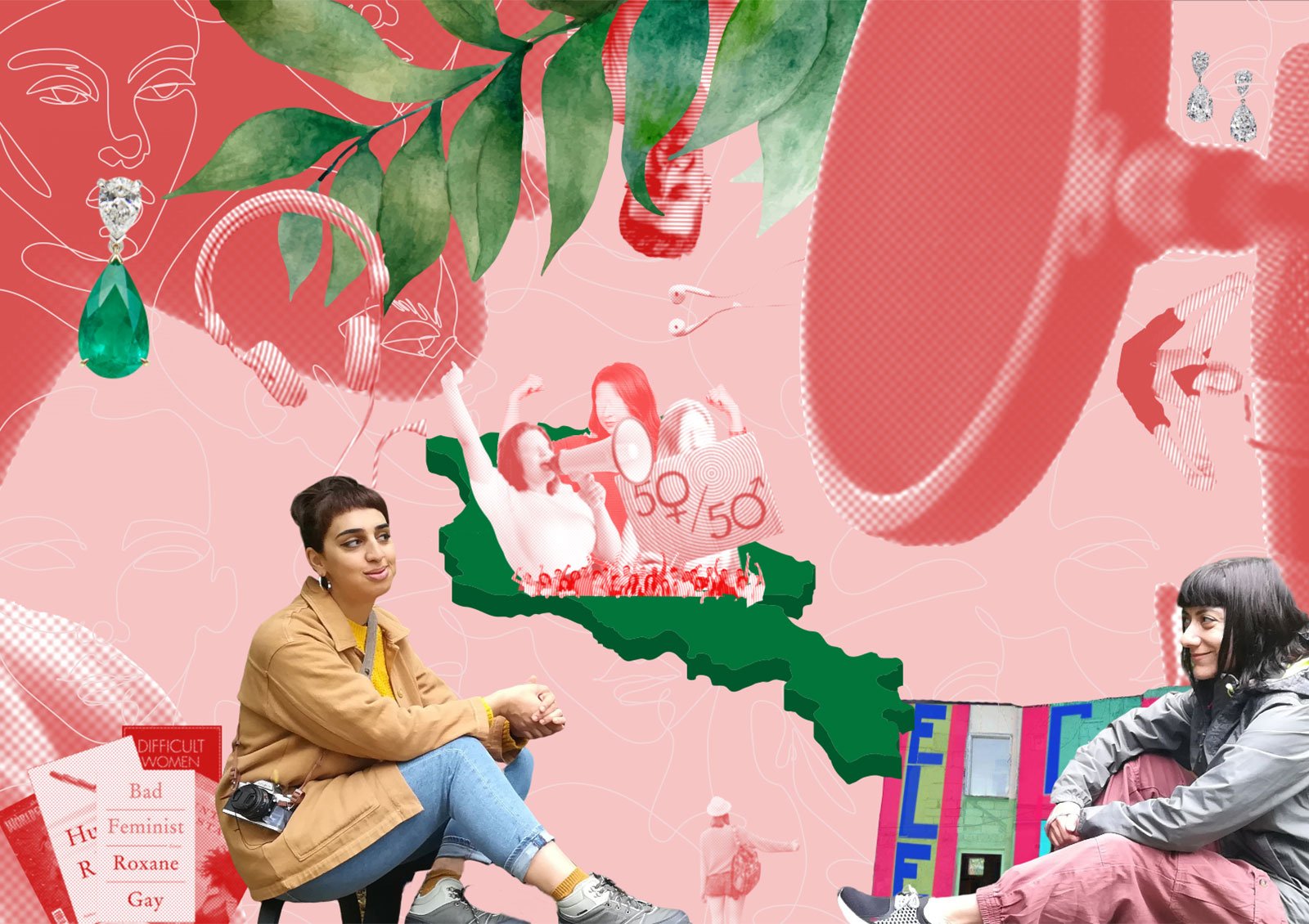Letter from Yerevan: as the clouds of conflict fade, creativity offers new hope
When fighting ground to a halt in the region of Nagorno-Karabakh last year, Armenia was forced to grapple with defeat. There was the loss of Armenian-controlled territory, given away to Azerbaijan in a Russian-broken peace deal. There was the loss of people who never came home from the frontlines. And there was the loss of identity and pride — leaving post-war Yerevan to fracture with internal political divides.
Exactly five months after the start of the war on 27 September, the early morning sees partygoers at Poligraf, Yerevan’s thriving club and live music venue, dancing at the launch event of YERAZ, an LP bringing together Armenian artists from around the world. “YERAZ reflects the richness and resilience of Armenian people; persevering through thousands of years of history and flourishing everywhere they go,” explains Zach Asdourian, the executive producer of the album. Asdourian is also founder of Critique, an LA-based record label, and he flew to Yerevan in February to present the LP and scout for more up-and-coming Armenian artists. That night, the message was clear: after the conflict, Yerevan was still ready to stand up, dance, and celebrate life.
But creative movements in Yerevan have both been scorned for “moving on” from the war while society remains in mourning, and sneered at as a non-priority during a rocky economic downturn. But creatives in Yerevan remain intent on rebuilding — reforging a new sense of purpose and identity through art. They believe that culture could be the only way to breathe fresh air into a city smothered in grief.
Image: Hrant Khachatrian
“Working with local musicians here in Yerevan, I have seen that the post-war logic among the artists here is that their craft is more important than ever, in order to help their fellow citizens heal from the recent losses and to help write a new, empowering narrative that brings hope rather than apathy to Armenians locally and globally,” explains Asdourian. “People might say that the priority should be military investment or something that’s more physically connected to our sovereignty, but I believe that the re-imagining and marketing of our culture to the rest of the world will help us achieve sovereignty and defend ourselves from military threats.”
2020 had already been a difficult year for Yerevan. Two years ago, a peaceful protest movement known as the Velvet Revolution overthrew the country’s corrupt regime, and the capital was thriving under a renewed sense of hope and creative energy. As a result, cultural initiatives — from galleries to feminist NGOs and performance venues — had blossomed. Outdoor cafés and trendy bars flourished in downtown Yerevan, revellers taking to paved terraces all year-round. And while the otherwise booming cultural scene took an obvious hit during the pandemic, it also experienced an unforeseen rebirth. In a country marked by emigration, a locked down summer meant that many Armenians were forced back home, hungry for social life after months in isolation. Still, creative energy was fading. “After the revolution a wave of motivation came. But before the war, the wave went down as the expectations were illogically high from the revolution, and there was a feeling of stagnation already sinking in,” explains Melineh, aka Lav Aghjik, (“Good Girl”), a local DJ and singer, and a regular of Yerevan’s live music venues.
Then the sound of artillery ripped through the capital. “We had spent weeks organising Play for Beirut, a fundraiser club night, both in-person and online, to help the victims of the blast in Lebanon. It is usually difficult to get DJs that work in different venues to play together, but everyone agreed to fight together for this cause,” says Melineh, who came back to Yerevan in 2019 after living in Lebanon for seven years. “That day, I woke up late, and I had 15 missed calls. We were at war.”
Image: Hrant Khachatrian
The late summer urban buzz was replaced by round-the-clock agony as Armenian and Azerbaijani forces clashed in the disputed territory of Nagorno-Karabakh, known to Armenians as Artsakh. While both countries claimed the land as their own, the area had remained in a tense ceasefire since the First Nagorno-Karabakh War ended in 1994. When fighting broke out again on 27 September 2020, the tension in Yerevan was palpable.
“I was clueless; I thought, what should we do? Can we still dance for another cause when our country is at war?,” says Melineh. “The answer made itself obvious a few hours later, when two of the DJs cancelled. They had already been called to the frontlines.”
Soon, many creatives — graphic designers, copywriters, digital marketers — had put aside their day jobs and joined a grassroots PR movement to craft slogans and posters that would draw international attention to the conflict. Journalists and photographers travelled to Nagorno-Karabakh, while the capital’s creatives rushed to raise funds for aid groups.
While the Beirut fundraiser night was cancelled, culture wasn’t completely pushed aside during the conflict. Poligraf continued to hold its weekly nights and dedicate the money to fundraisers. Art galleries and hotels repurposed their spaces as shelter for refugees. The doors of TUMO Stepanakert, the Nagorno-Karabakh branch of Armenia’s leading media education centre, closed, but the school’s social media pages kept sharing the work from its students in the region. “In peacetime, it’s the shepherds who guard the mountains of Artsakh. TUMO Stepanakert alum Arnold Ghazaryan’s photo story is from that time,” read the caption in a post from 5 October. “Now Arnold is serving in the Artsakh army, guarding our borders. We can’t wait for his return and for new photos of an even more peaceful land.”
A peace deal finally put an end to the fighting some 44 days after it began. Yet while the physical conflict ceased, many were left struggling in the aftermath. “On the last day of the war, when we found out about the peace deal, we almost felt like laughing. It sounds horrible to say, but everything seemed so meaningless. We were so exhausted; our bodies couldn’t handle it anymore,” one friend tells me.
Continuing to work after the war, was even harder than after the Covid lockdown,” explains Davit Sukiasyan, founder of Poligraf. “But we did it because cultural initiatives are there to heal people.
One of Yerevan’s creative hubs, Mirzoyan Library, whose founder had been restlessly photographing the war, announced on Instagram that it would be closing its doors. “In these difficult times, we all need time to look back at what we have done in the past, to rethink what we will be doing in the future [...]. Or just understand if we still can do anything in the future.”
Within a few days however, it became clear that Yerevan’s cultural scene would bounce back. Venues continued operating; even Mirzoyan Library eventually reopened its doors. Four months on, the visible traces of the war are few in Yerevan. “Before January there was a pause, which was normal, as people were mourning, trying to digest the war and its circumstances, but now there is a wave of events again,” says Melineh. Poligraf continues to sell out on their weekly nights, creating a platform to switch off and dance with all-female music nights, emerging musicians, and experimental events. “Continuing to work after the war, was even harder than after the Covid lockdown,” explains Davit Sukiasyan, founder of Poligraf. “But we did it because cultural initiatives are there to heal people.”
Only in February, Melineh was on the stage of Poligraf twice, playing her track in the launch party of YERAZ, and another time with her band on 8 March, in an event celebrating female musicians on International Women’s Day. Mirzoyan has once again filled its balconies with photography aficionados, remote workers and freelance creatives grabbing a drink, attending film screenings, or listening to DJ sets. Even TUMO Centre reopened its doors in Stepanakert, and their Instagram pictures of clothes lines hanging in the capital of Nagorno-Karabakh are encouraging signs of new life. The Tamanyan Architecture Museum in Yerevan opened an exhibition of hundred-year-old carpets that used to be on display at the Carpet Museum in Shushi, a city in Nagorno-Karabakh now under Azerbaijani control. And in late December, Dalan Art Gallery in Yerevan inaugurated Listening to Imagine, a platform to invite artists and audiences to engage in envisioning different possibilities for the future.
Image: @Saiko3p
But while cultural initiatives both during and after the war are imbued with a sense of solidarity, creatives face a less supportive environment as the government cuts back support in the arts — and some Armenians see creative escapism as an attempt from people to hide from Armenia’s social difficulties.
“Even before the war, there was lack of support from the government towards culture,” explains Victoria Aleksanyan, a filmmaker, activist, and founder of Independent Filmmakers Association of Armenia, an organisation lobbying to gain government support for the country’s film industry. “In the eyes of the government, the war has decreased the urgency of the sector even more. It’s hard to say what the direction of the cultural industry is going to be, but many people have turned towards culture to heal. And there seems to be a clash with the government, who is even less interested than before to move the industry forward.”
Against all odds, the cultural scene in Yerevan has the opportunity to gather momentum, to be in its best moment.
The political situation also remains fraught, as opposition parties organise daily protests to demand the Prime Minister’s resignation. “Daily routine in Yerevan: check [where the protests are], so that you don’t accidentally join one,” one user wrote on Twitter. The post quickly went viral. With such instability taking over the city’s streets, and a burden of wartime debt asphyxiating the economy, most see investing in culture as unnecessary. “There is a feeling in government that we don’t need culture now. Many people don’t understand why we need post-conflict cultural policy,” a friend who works for a local ministry tells me. “This is something that has been practised around the world. Many ministries have post-conflict policies, but not the Ministry of Culture. The main point of the policy is to implement culture in all areas of post-conflict reality, and fix problems: be them organisational, political, economic, through culture. If people weren’t caught up with internal political divisions they would realise that culture can make the economy grow, but it can also help the people heal.”
In reality, the Yerevan cultural scene is still finding its feet, and it is too early to identify many post-war cultural initiatives, what their impact will be, or what their focus is. Still, there is a desire to move forward. “We still haven’t decided whether to hold it [the fundraiser event for Beirut] or not,” says Melineh. “But we thought that, now that we have gathered the musicians, instead of just Play for Beirut, we could turn it into Play For, a regular event to fundraise for humanitarian causes, through club nights”.
Yet ultimately, mourning takes many different forms. In a small country, where the entire population has been affected by the war in one way or another, even grabbing a drink is a purposeful act of hope. Some cultural initiatives directly fundraise for war-related causes, some deal with the idea of heritage conservation — and some do not touch on the topic altogether. But culture does not exist in a vacuum, and every expression of creativity — organising an exhibition, fundraising, or standing up and dancing — amid this new sea of political uncertainty is a conscious sign of purposeful resilience. Artists are not only creating culture, but also creating a sense of hope that the city will move on.
With this, they also hope to usher in a new, creative rebirth. It takes courage to turn loss into creativity. Yet culture is what kept the spirits up during the war, culture is what has kept alive Armenian’s sense of heritage from ancient times to the present, and culture could be the only avenue to keep Armenia’s national identity from giving into external threats and internal divisive forces. Yet after a military defeat, Armenia could rebuild a sense of national pride with its thriving cultural industry — and for that, government support is needed.
“Before, people used to say that Armenia is like a swamp for creatives. People were demotivated. I think after the war, we understood that only hard work can save us and help Armenia win — metaphorically, not the war,” says Melineh. “In chaotic situations, creativity takes over. We understood that unless we work hard to develop our country, we won’t move forward.”
In the span of just a few days in February 2021, two earthquakes shook the capital. Warm weather timidly appears only for an hour or two, until biting cold, rain and heavy snow rush back — a warning that the gentle awakening of spring won’t come easily this year. Yet on sunny days, at golden hour, Yerevan lives up to its “pink city” epithet. A warm hue surrounds the city, making it look like it’s rising from the ground up to the sky — proof that beauty can still be found even in the hardest of times. “Pain, whether at the level of a person or a country, always has a chance to affect positively because it gives you a space to open up and try new things,” says Sukiasyan. “Against all odds, the cultural scene in Yerevan has the opportunity to gather momentum, to be in its best moment.”

